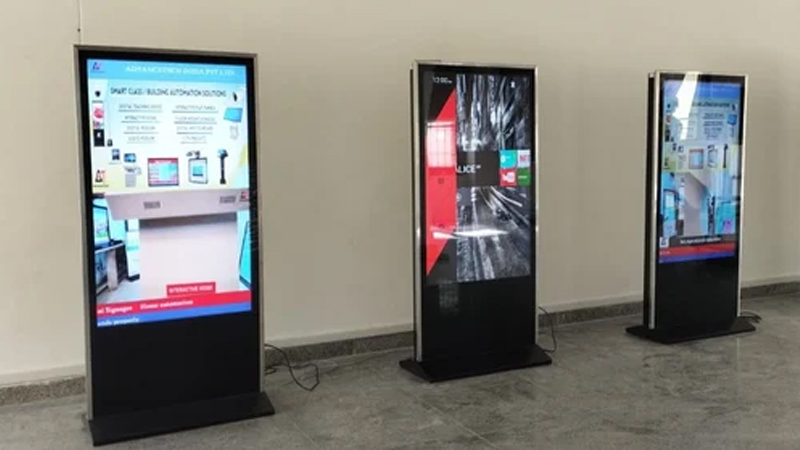Main advantages of digital signage
Main advantages of digital signage
By Samidisplay / September 2, 2023

Digital signage offers numerous advantages across various industries and applications.
Here are some of the main advantages:
Dynamic Content: Digital signage allows for the display of dynamic content, including videos, animations, and real-time data. This dynamic nature captures and holds viewers' attention more effectively than static signage.
Real-time Updates: Content on digital signage can be updated instantly and remotely, eliminating the need for physical replacements and reducing maintenance costs. This flexibility is crucial for businesses with changing information or promotions.
Cost Efficiency: While there's an initial investment in hardware and software, digital signage can be cost-effective in the long run, as it reduces printing and distribution costs associated with traditional signage. It also offers the potential for revenue generation through advertising partnerships.
Increased Engagement: The use of multimedia and interactive elements in digital signage increases viewer engagement. Engaged viewers are more likely to absorb the message and take desired actions.
Audience Targeting: Digital signage can be programmed to display content based on audience demographics, location, or time of day. This personalization makes the content more relevant and effective.
Remote Management: Many digital signage systems allow for remote management, enabling content updates, scheduling changes, and troubleshooting a central location. This is particularly valuable for businesses with multiple locations.
Enhanced Branding: Digital signage can reinforce branding and messaging consistently across all locations. It provides an opportunity to create a cohesive brand image and maintain brand standards.
Data and Analytics: Digital signage systems often offer data collection and analytics capabilities. This data can provide valuable insights into viewer behavior, allowing for content optimization and campaign measurement.
Flexibility: Digital signage can adapt to various environments and purposes. It's suitable for retail promotions, wayfinding in large venues, employee communication in corporate settings, and more.
Time-sensitive Information: In transportation hubs, healthcare facilities, and other time-sensitive environments, digital signage can display real-time information such as schedules, wait times, and announcements.
Eco-friendly: Digital signage reduces the need for printed materials, making it more environmentally friendly. Additionally, energy-efficient displays and LED technology contribute to lower energy consumption compared to traditional illuminated signs.
Interactivity: Interactive digital signage, such as touchscreens or QR code integration, enables user engagement and self-service options, enhancing the customer or visitor experience.
Emergency Messaging: Digital signage can be repurposed quickly to display emergency alerts and critical information, improving safety and communication during crises.
Competitive Advantage: Businesses that adopt digital signage can gain a competitive edge by showcasing innovation and a commitment to modern customer engagement.
Improved Customer Experience: In retail and hospitality, digital signage can provide valuable information, entertain customers, and guide them through the buying process, ultimately enhancing the overall customer experience.
Space-saving: Digital signage eliminates the need for multiple static signs, freeing up physical space and reducing clutter in crowded environments.
An important feature of the digital signage network is that the content can be updated in real time, so users can set the update frequency according to their actual application needs and information content. Specifically, the update of digital signage content depends on the influence of the target audience on different times of the day or week. For example, the content being broadcast is for young people under the age of 25, and such information is obviously not suitable for playing in the morning, but should be placed in the afternoon to ensure that the student party can see it during the afternoon break.
At the same time, it is necessary to pay attention to the content update of certain days, it is best to have targeted content launch, so that not only can the freshness of the content, but also make the information dissemination look more humanized, thus deepening the impression of the audience.
How to control the frequency of content updates? In practice, the easiest way to do this is to update it three times a day, once in the morning, in the middle, and in the evening. This method can ensure the freshness of digital signage content, not only to attract the attention of the audience, but also to cultivate the viewer’s continuous viewing habits. After the content is rearranged, although the overall content has not changed, it will bring a certain freshness to the audience. At the same time, it also ensures high-frequency playback of important content, ensuring that viewers of all time periods can receive, the largest expansion. Spread the scope to achieve efficient dissemination. Of course, this method does not apply to some of the more demanding customers. For them, it is constantly added or deleted to ensure that the content is fresh, although complex, it is really “fresh”.
In order to ensure the best communication effect, the content update can not simply rely on frequency definition, but also target the target audience, and push specific information to specific people in time. If the scope is too broad, even if it is pushed 24 hours a day, the efficiency will be Not too high, so the value of digital signage is greatly reduced. The basic principle is that different screen displays are communicated to different people at different times.
Overall, digital signage offers versatility, efficiency, and effectiveness in conveying messages, engaging audiences, and achieving various business objectives. Its adaptability and ability to provide real-time, relevant information make it a valuable asset in today's dynamic and competitive business landscape.
 Sami Technology Co., Ltd.
Sami Technology Co., Ltd.
